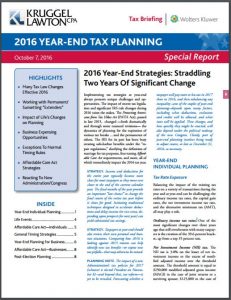
Straddling Two Years Of Significant Change
Implementing tax strategies at year-end always presents unique challenges and opportunities. The impact of recent tax legislation and significant IRS rule changes during 2016 raises the stakes. The Protecting Americans from Tax Hikes Act (PATH Act), passed in late 2015, changed —both dramatically
and through some nuanced revisions— the dynamics of planning for the expiration of various tax breaks …and the permanence of others. The IRS for its part has been busy creating safe-harbor benefits under the “repair regulations,” clarifying the definition of marriage for tax purposes, fine-tuning Affordable Care Act requirements, and more, all of which immediately impact the 2016 tax year.
STRATEGY. Income and deductions for the entire year typically become more clear for most taxpayers as they move ever closer to the end of the current calendar year. The final months of the year provide
an important “last chance” to change the final course of the entire tax year before it closes for good. Initiating traditional techniques designed to accelerate deductions and delay income (or vice versa, depending upon prospects for next year) can yield substantial tax savings.
STRATEGY. Taxpayers at year-end should also review their own personal and business situations. Comparing how 2016 is looking against 2015 returns can help identify new tax benefits –or expose new tax pitfalls-- that may otherwise be missed.
PLANNING NOTE. The impact of a new Administration’s tax policies for 2017 and beyond that, tax reform—is yet to be revealed. Forecasting whether a taxpayer will pay more or less tax in 2017 than in 2016, and then rebalancing any inequality –one of the staples of year-end planning--depends upon many factors, including what deductions, exclusions and credits will be allowed, and what rates will be applied. These changes, and how quickly they might be enacted, will also depend under the political makeup of the new Congress. Clearly, part of year-end planning involves being ready to adjust course, as late as December 31, 2016, as necessary.
Of course, each person and business situation is unique so please contact a Kruggel Lawton tax advisor to learn exactly which strategies can benefit you the most. Call us at 574.289.4011 or send us a message.
Please fill out the form to download the complete 2016 Year-End Tax Planning Guide.